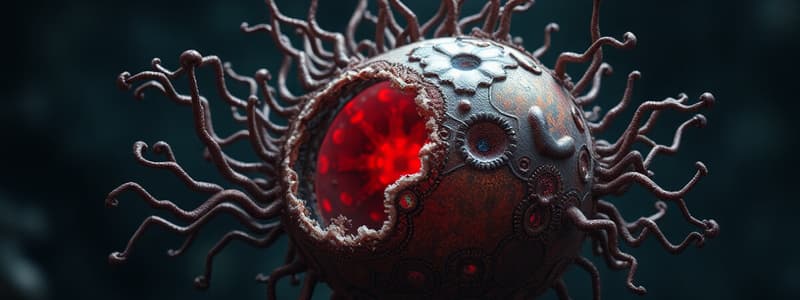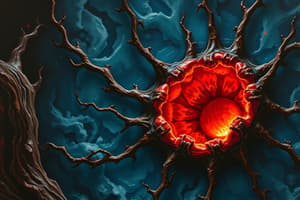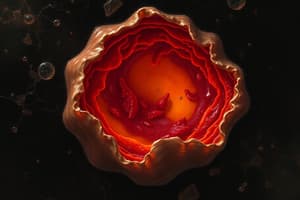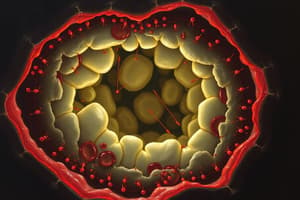Podcast
Questions and Answers
Which of the following best describes the role of energy in apoptosis?
Which of the following best describes the role of energy in apoptosis?
- Energy is only required in the extrinsic pathway of apoptosis.
- Apoptosis is an energy-dependent process. (correct)
- Apoptosis is an energy-independent process.
- Energy is only required in the mitochondrial pathway of apoptosis.
What is a key feature of DNA during apoptosis?
What is a key feature of DNA during apoptosis?
- Mitochondrial DNA is primarily affected.
- Random, haphazard fragmentation.
- DNA remains intact until the cell membrane lyses.
- Inter nucleosomal cleavage leading to DNA laddering. (correct)
How does the cytoplasm typically appear during apoptosis?
How does the cytoplasm typically appear during apoptosis?
- Swollen and ruptured.
- Unchanged in size until cellular contents spill out.
- Shrunk without membrane rupture. (correct)
- Shriveled and condensed with membrane lysis.
What is the immediate fate of cellular content in apoptosis?
What is the immediate fate of cellular content in apoptosis?
Which condition is generally a characteristic of necrosis, but not apoptosis?
Which condition is generally a characteristic of necrosis, but not apoptosis?
Which term best describes the inflammatory response associated with necrosis?
Which term best describes the inflammatory response associated with necrosis?
How does the nuclear membrane interact with chromatin during apoptosis?
How does the nuclear membrane interact with chromatin during apoptosis?
What are the key processes that differentiate apoptosis from necrosis?
What are the key processes that differentiate apoptosis from necrosis?
Which process triggers apoptosis?
Which process triggers apoptosis?
Which of the following best describes the appearance of DNA during necrosis?
Which of the following best describes the appearance of DNA during necrosis?
Which of the following is a key characteristic of reversible cell injury, as opposed to irreversible injury?
Which of the following is a key characteristic of reversible cell injury, as opposed to irreversible injury?
What is the primary role of caspases in the context of apoptosis?
What is the primary role of caspases in the context of apoptosis?
In a cell undergoing necrosis, which of the following cellular changes would you least likely expect to observe?
In a cell undergoing necrosis, which of the following cellular changes would you least likely expect to observe?
Which of the following best illustrates the morphological changes in a cell transitioning from healthy to necrotic, focusing on the mitochondria?
Which of the following best illustrates the morphological changes in a cell transitioning from healthy to necrotic, focusing on the mitochondria?
What role does the mitochondrial pathway play in apoptosis induction?
What role does the mitochondrial pathway play in apoptosis induction?
Which of the following best describes a key morphological difference between cells undergoing necrosis and apoptosis when examined microscopically?
Which of the following best describes a key morphological difference between cells undergoing necrosis and apoptosis when examined microscopically?
Which cellular process is most associated with free radical formation as a key mechanism of cell injury?
Which cellular process is most associated with free radical formation as a key mechanism of cell injury?
What is the most important distinction between reversible and irreversible cell injury based on cellular morphology?
What is the most important distinction between reversible and irreversible cell injury based on cellular morphology?
What is a hallmark process of apoptosis that distinguishes it from necrosis?
What is a hallmark process of apoptosis that distinguishes it from necrosis?
A cell undergoing hydropic change, where its internal environment changes due to disruptions to ion and water balance, would be classified as undergoing which process?
A cell undergoing hydropic change, where its internal environment changes due to disruptions to ion and water balance, would be classified as undergoing which process?
Flashcards
Apoptosis
Apoptosis
Programmed cell death, characterized by a series of events leading to cell dismantling, without triggering inflammation.
Extrinsic Pathway of Apoptosis
Extrinsic Pathway of Apoptosis
A pathway of apoptosis triggered by external signals, typically signaling molecules like TNF-alpha or Fas ligand.
Mitochondrial Pathway of Apoptosis
Mitochondrial Pathway of Apoptosis
A pathway of apoptosis triggered by internal signals, often related to mitochondrial dysfunction or DNA damage.
Apoptosis is Energy Dependent
Apoptosis is Energy Dependent
Signup and view all the flashcards
Chromatin Condensation and DNA Fragmentation
Chromatin Condensation and DNA Fragmentation
Signup and view all the flashcards
Cell Shrinking and Membrane Integrity
Cell Shrinking and Membrane Integrity
Signup and view all the flashcards
Formation of Apoptotic Bodies
Formation of Apoptotic Bodies
Signup and view all the flashcards
Physiological Role of Apoptosis
Physiological Role of Apoptosis
Signup and view all the flashcards
Apoptosis Triggered by Lack of Survival Signals
Apoptosis Triggered by Lack of Survival Signals
Signup and view all the flashcards
Necrosis
Necrosis
Signup and view all the flashcards
Reversible Cell Injury
Reversible Cell Injury
Signup and view all the flashcards
Irreversible Cell Injury
Irreversible Cell Injury
Signup and view all the flashcards
Anoikis
Anoikis
Signup and view all the flashcards
ATP Depletion
ATP Depletion
Signup and view all the flashcards
Mitochondrial Damage
Mitochondrial Damage
Signup and view all the flashcards
Calcium Changes
Calcium Changes
Signup and view all the flashcards
Free Radicals
Free Radicals
Signup and view all the flashcards
Study Notes
Cell Injury and Cell Death
- Cell injury occurs due to biochemical and morphologic changes
- It is caused by exogenous factors (like trauma, heat, cold, radiation, chemicals, bacterial toxins and drugs) or endogenous factors (like inborn errors of metabolism, sickle cell disease, intestinal malabsorption, obesity and malnutrition)
- Cell injury results in reversible damage or irreversible disruption of normal cell function
- Hypoxia is a decrease in the supply of oxygen, caused by a complete block in the oxygen supply
- Anoxia is a condition where there is a lower concentration of oxygen in the air; examples include high altitude or drowning and lung disease. Other examples of this are anemia, Ischemia, thrombosis, embolism, rupture of an aneurysm, and cyanide poisoning.
Learning Objectives
- List causes of cell injury
- Describe effects of cell injury
- Define reversible and irreversible cell injury
- Compare reversible and irreversible cell injury
- Define necrosis and apoptosis and list main differences
- List characteristic cellular changes observed in necrosis
- List characteristic cellular changes observed in apoptosis
- Compare/contrast healthy and necrotic cells based on morphology in H&E stained and electron micrograph images
- Describe mechanisms of apoptosis and its regulation
- Diagram intrinsic and extrinsic pathways of apoptosis induction, emphasizing proteins activating caspases
- Differentiate between necrosis and apoptosis based on cellular morphology in microscopic images
- Define anoikis and correlate it with tumor metastasis
Cell and Tissue Injury
-
Cell injury is a consequence of biochemical and morphologic changes
-
Causes include exogenous (e.g. trauma, heat/cold, radiation, chemicals) and endogenous factors (e.g., metabolic errors, nutritional deficiencies).
-
Reversible cell injury may involve swelling of endoplasmic reticulum and mitochondria, membrane blebs and myelin figures. Recovery is possible.
-
Irreversible injury results in necrosis or apoptosis
Exogenous Causes of Cell Injury
- Physical injury: Trauma, heat or cold; ultraviolet light or ionizing radiation
- Chemical injury: Alcohol or corrosive substances
- Bacterial toxicity: Cholera toxin inducing watery diarrhea, mercury toxicity to the kidneys
- Drug toxicity: Mercury toxicity to the kidneys
Endogenous Causes of Cell Injury
- Genetic defects: Inborn errors of metabolism, sickle cell disease
- Nutritional deficiency: Intestinal malabsorption resulting from celiac disease, obesity, malnutrition
What Happens to Injured Cells?
- ATP depletion: Detachment of ribosomes; increased anaerobic glycolysis; lactic acid accumulation; decreased activity of enzymes; reduced activity of plasma membrane ATP-dependent sodium pumps; lysosomal membrane damage.
- Mitochondrial damage: Swelling of the inner mitochondrial membrane; altered membrane permeability; affecting transmembrane potential and opening of pores
- Calcium changes: Loss of calcium homeostasis; effects within the cell; activation of ATPases, proteases, phosphatases and endonucleases.
- Free radical formation: Reactions with inorganic and organic material; production and removal rates of free radicals; lipid peroxidation leading to membrane damage; protein modifications leading to mis-folding; DNA damage leading to mutations
Types of Cell Injury
- Two types: Reversible and irreversible
- Reversible causes: Exposure to toxins in low concentration, brief hypoxia or anoxia
- Irreversible causes: Heavy doses of toxins, anoxia, severe and prolonged hypoxia, or injury that is unable to recover from
Reversible Cell Injury
- A form of cell injury in which the cell can recover to its original steady state
- The changes produced are called reversible cell injury
- If adverse environmental influences evoke a cellular response that remains within the range of homeostasis then responses remain within the range of homeostasis and cells return to original state after cessation of injury
- Recognized by: Mild injury that happens in the body, short-lived, like a cold or virus, induced by low concentration of toxins, hypoxia, or brief period of anoxia during anaerobic respiration, disruption of Na+/K+ ATPase pump going back to normal
- Leading to: Cell swelling, impaired cellular regulation; mitochondria and endoplasmic reticulum swelling with detachment of ribosomes; surface blebs due to increased calcium, leading to changes in the microfilaments of the cytoskeleton; loss of microvilli structure
Irreversible Cell Injury
- Permanent damage; cannot come back to original function; may lead to cell death
- Occurs when cells are exposed to causes of cell injury and cannot recover; this is a 'point of no return'
- Cell death happens in two ways: necrosis and apoptosis
- Depending on the cause of injury, either necrosis or apoptosis will be the outcome
Necrosis
- The following nuclear changes occur:
- Pyknosis: irreversible condensation of chromatin
- Karyorrhexis: destructive fragment of the nucleus or nucleus burst
- Karyolysis: complete dissolution of the chromatin by endonucleases; basophilia of the nucleus fades
- The following cytoplasmic changes occur: swelling of the organelles (especially mitochondria) and rough ER; rupture of the plasma membrane leading to spillage of all cytoplasmic contents
Types of Necrosis
- Coagulative necrosis: The most common; tissue remains firm; architecture is preserved; cell shape and organ structure are preserved for few days; caused by ischemia or infarction
- Liquefactive necrosis: Tissue becomes liquefied through enzymatic action; maintains cheese-like appearance
- Caseous necrosis: Dead tissue appears soft and white; frequently associated with TB
- Gangrene: Dry gangrene is coagulative necrosis resembling mummified tissue; wet gangrene is superimposed infection and then liquefactive necrosis
- Fat necrosis: Involves adipose tissue; restricted to smooth muscle wall of small arteries, arterioles, and renal glomeruli
- Fibrinoid necrosis: Necrotic tissue and debris disappear by a combined process, or if not destroyed, they attract calcium salts and other minerals resulting in calcification
Apoptosis
-
A type of programmed cell death
-
Two types: Intrinsic (or Mitochondrial) pathway and Extrinsic (or Death Receptor) pathway
-
Intrinsic pathway: When mitochondria experience damage or an altered cell cycle, they secrete factors (e.g., cytochrome C) and activate procaspase 8
-
Extrinsic pathway: Cell surface death receptors (e.g., Fas receptor) are triggered.
-
When mitochondrial membranes become permeable, cytochrome C leaks to the cytoplasm; triggers procaspase 9 activation, leading to apoptotic death
-
AIF (Apoptosis-inducing factor): Moves to the nucleus, binds to DNA and leads to cell death without caspase participation
-
Granzyme B and Perforin: Cytotoxic T cells secrete granzyme B and perforin. Granzyme B enters the infected cell and perforin forms pores on the cell membrane.
-
Causes of apoptosis include growth factor withdrawal, DNA damage, and protein misfolding.
Anoikis
- A special form of apoptotic process occurring in cells in response to loss of adhesion to the ECM
- Critical for maintaining tissue homeostasis
- Some cancer cells develop mechanisms to escape anoikis, which can lead to seeding in inappropriate sites
Other Forms of Programmed Cell Death
- Autophagy, paraptosis, pyroptosis, mitotic catastrophe, and entosis are other types of programmed cell death, including the uncontrolled mechanism of necrosis.
Apoptosis vs Necrosis
- Necrosis is a pathological response to cell injury and Apoptosis is a normal cell response for elimination, following specific signals.
- Chromatin clumping and mitochondrial swelling/rupture are characteristics of necrosis. Cytoplasmic shrinkage is a feature of apoptosis.
Note: Please refer to the provided images for detailed illustrations of the cellular changes. This summary provides an overview and does not replace detailed study using the images.
Studying That Suits You
Use AI to generate personalized quizzes and flashcards to suit your learning preferences.



